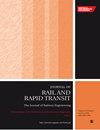Wheel profile optimization for intercity EMUs based on the Gaussian function correction method
IF 2.1
4区 工程技术
Q3 ENGINEERING, CIVIL
Proceedings of the Institution of Mechanical Engineers Part F-Journal of Rail and Rapid Transit
Pub Date : 2024-02-27
DOI:10.1177/09544097241229142
引用次数: 0
Abstract
Intercity EMUs are prone to wheel flange wear and tread wear due to the high operating speed and many small radius curved tracks. The problems caused by wheel wear have seriously affected the safety of high-speed railway operations in China. In this paper, based on the original LMA wheel profile, the Gaussian function correction (GFC) method is proposed to design the wheel profile. The GFC method mainly changes the root region of the wheel flange, to enhance the curve passing performance and reduce wheel wear of the vehicle. The optimal profile is optimized by the Kriging surrogate model (KSM) and the whale optimization algorithm (WOA). The wheel-rail contact characteristics, dynamic characteristics and the wheel wear of the wheel profiles before and after optimization are simulated and analyzed. The results show that the equivalent conicity of the optimized profile is reduced; the critical speed is increased by 9.3 km/h, the lateral ride index and comfort index of the vehicle are further reduced. The curve passing performance is also improved, the wheel-rail wear of the optimized profile is further reduced and the maximum wear depth of the wheels before and after optimization is 43.4e-9m and 34.1e-9m on the curved track with a radius of 500m, which is reduced by 21.43%. This method provides a reference and basis for wheel profile design and profile re-profiling of intercity EMUs.基于高斯函数修正法的城际动车组轮廓优化
城际动车组由于运行速度高、小半径曲线轨道多,容易出现车轮轮缘磨损和胎面磨损。车轮磨损带来的问题严重影响了我国高速铁路的运营安全。本文在原有 LMA 车轮轮廓的基础上,提出了高斯函数修正法(GFC)来设计车轮轮廓。GFC 方法主要改变车轮轮缘的根部区域,以提高车辆的曲线通过性能,减少车轮磨损。通过克里金代用模型(KSM)和鲸鱼优化算法(WOA)对最佳轮廓进行优化。模拟并分析了优化前后车轮轮廓的轮轨接触特性、动态特性和车轮磨损情况。结果表明,优化后轮廓的等效锥度降低,临界速度提高了 9.3 km/h,车辆的横向行驶指数和舒适指数进一步降低。曲线通过性能也得到改善,优化后的轮轨磨损进一步降低,在半径为 500m 的曲线轨道上,优化前后车轮的最大磨损深度分别为 43.4e-9m 和 34.1e-9m,降低了 21.43%。该方法为城际动车组的车轮轮廓设计和轮廓调整提供了参考和依据。
本文章由计算机程序翻译,如有差异,请以英文原文为准。
求助全文
约1分钟内获得全文
求助全文
来源期刊

CiteScore
4.80
自引率
10.00%
发文量
91
审稿时长
7 months
期刊介绍:
The Journal of Rail and Rapid Transit is devoted to engineering in its widest interpretation applicable to rail and rapid transit. The Journal aims to promote sharing of technical knowledge, ideas and experience between engineers and researchers working in the railway field.
 求助内容:
求助内容: 应助结果提醒方式:
应助结果提醒方式:


